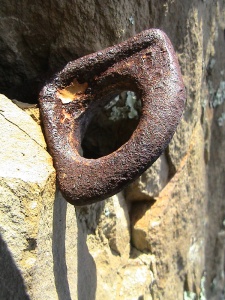I remember a day in a Colorado canyon, on the side of a 750-foot cliff. I had taken a less experienced climber up a route that would take us a few hours. We were near the top, resting at a belay together before the final stretch of climbing, an exposed section that lead out on semi-rotten rock. The only protection against falling in this part of the rock wall were small metal nails, called pitons, hammered into the rock what looked like decades earlier. They appeared very old and rusted.


There would be a lot of empty air under our heels as we made the moves. We were thirsty and out of water. The view was spectacular, but despite the fact that I had led us to this place, the anticipation of the next part sat very heavy in the pit of my stomach. I asked my friend if he wanted to take the lead on the final section, but he didn’t want it and I didn’t blame him – it was a daunting prospect. I had got us into this and I had to get us out.
I sat there considering the options. Retreating from our location would have been at least as risky, if not more so, than going up. Daylight was waning. I had to go on. I checked to make sure my gear was in order and steeled myself to move. The first part was mostly sideways, angling up a little past those ancient pitons. I didn’t look at or think about anything except placing my hands and feet, testing each hold gingerly before fully committing my weight. Everything held and at the end of the traverse, I looked back at my friend, only 20 feet away, but with hundreds of feet beneath us. He was holding my rope and paying full attention to the situation. We were bound together by that thin cord. Our eyes met, but we said nothing and I smiled a little as I headed up over a vertical section of rock to easier ground and, eventually, to the top of the climb. We made it without mishap.
For me, climbing is a form of meditation and an art form. It is a practice that requires discipline, focus, and strength, both mental and physical. It is about the objective hazards of putting your body in places that your consciousness says are not okay and dealing with the emotional, psychological, and physical consequences of that choice. It is also about solitude and the wilderness and bonding with a friend.
I have been a rock climber for 27 years. At 47 years old, I’ve climbed for more than half my life, putting in thousands of hours and miles of vertical distance. The lessons that I learn are often hard to put into words, but it is part of my life now and I celebrate every opportunity I have to practice.
So much of what we do in life is about trying to keep calm in the face of challenges that literally make us sick. We would do anything to avoid painful circumstances that, if we face the truth, we put ourselves in. When climbing, there is no avoiding the situation. You must deal with it or the consequences will be immediate and severe. You must face your fears head on.
This does not mean you ignore your fears. As I climbed past those old pitons, I connected my rope, and thus my body, to them. And I was afraid at the same time. That fear was justified, because I had little confidence that they were strong enough to hold me if I had fallen. At times the fear of a particular climb has caused me to avoid it and even to head home early. Who knows what would have happened in those cases, but there is little doubt that the fear is rational and should be headed sometimes. As I like to say, a good day of climbing is a day in which you arrive home safely.



I really love to climb as well but have not been able to of late. Your piece brought the experience to me again. Thanks